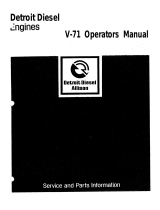
Safety 09
Ensure that all fuel injection lines and pressurized oil lines have sufficient distance to other
components to avoid contact w ith them. Do not place fuel or oil lines near hot components,
except when necessary for design reasons during installation.
Elastomers (e.g. "Viton" sealing rings) are stable under normal operating conditions. The material decomposes
when exposed to fire or temperatures exceeding 300 °C. Hydrogen fluoride vapors are released in this
case. The resulting acid leads to serious burning if it contacts the skin. Do not touch elastomeric seals
if they have carbonized or resinous appearance. Wear protective gloves!
Take care with hot fluids in lines, pipes and chambers ⇒ Risk of injury!
Note cooling period for components which are heated for installation or removal ⇒ Risk of injury!
Never touch hot parts of the compressor and exhaust system ⇒ Risk of burning!
Take special care when removing ventilation or plugs from engine. In order to avoid discharge of
highly pressurized liquids, hold a cloth over the screw or plug. It is even more dangerous if the
engine has recently been shut down, as the liquids can still be hot.
Take special care when draining hot fluids. ⇒ Risk of injury!
When draining, collect fluids in a suitable container, mop up any spilt fluids or wipe or
soak them with a suitable bonding agent.
When changing the engine oil or w orking on the fuel system, ensure that the engine room is adequately ventilated.
When working high on the engine, always use suitable ladders and work platforms. Make
sure components are placed on stable surfaces.
In order to prevent back injuries when lifting heavy components adults, depending on age and sex,
should only lift weights between max. 10 kg and 30 kg, therefore:
• Use lifting gear or seek assistance.
• Ensure that all chains, hooks, slings, etc. are tested and authorized, are sufficiently strong and that
hooks are correctly positioned. Lifting eyes must not be unevenly loaded.
Welding work
Never carry out welding work on the engine or engine-mounted units.
Never use the engine as a ground connection. This prevents the welding current passing through
the engine resulting in burnt/scorched bearings, sliding surfaces and tooth flanks which may
lead to bearing seizure and/or other material damage.
Never route the welding lead over or near the wiring harnesses of MTU systems. The w elding current may otherwise
induce an interference voltage in the wiring harnesses which could conceivably damage the electrical system.
The welding unit ground connection must not be more than 60 cm from the w eld point.
If components (e.g. exhaust m anifold) are to be welded, they must be removed from the engine.
It is not necessary to remove the connector and the connections when carrying out welding operation
on MTU electronics if the master switch for power supply is switched from "ON" to "OFF" and the wire
is disconnected from the negative and positive poles on the battery.
Hydraulic installation and removal
Only the hydraulic installation and removal equipment specified in the work schedule and
in the assembly instructions must be used.
The max. permissible push-on pressure specified for the equipment must not be exceeded.
The H.P. lines for hydraulic installation and removal are tested with 3800 bar.
Do not attempt to bend or apply force to lines.
Before starting work, pay attention to the following:
• Vent the hydraulic installation/removal tool, the pumps and the lines at the relevant points for the system to
be used (e.g. open vent plugs, pump until bubble-free air e merges, close vent plugs).
• For hydraulic installation, screw on the tool with the piston r etracted.
• For hydraulic removal, screw on the tool with the piston extended.
For a hydraulic installation/removal tool with central expansion pressure supply, screw spindle
into shaft end until correct sealing is achieved.
During hydraulic installation and removal, ensure that nobody is standing in the immediate vicinity of the
component to be installed/removed. As long as the system is under pressure, there is the risk that the
component to be installed/removed may be suddenly released from the pressure connection.
Before use, the tools must be checked at regular intervals (crack test).
M015715/00E 06-08 ©MTU




















